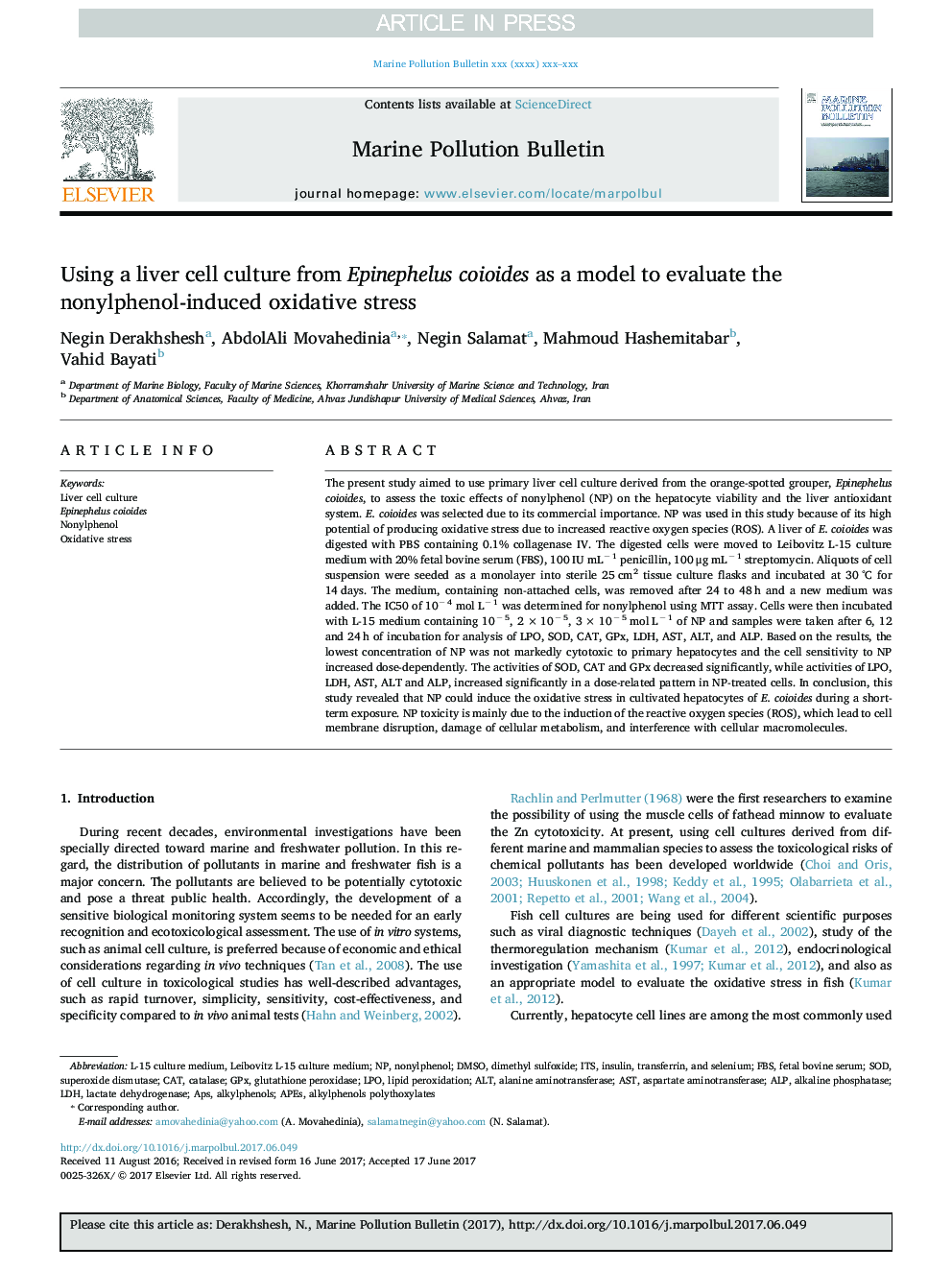| کد مقاله | کد نشریه | سال انتشار | مقاله انگلیسی | نسخه تمام متن |
|---|---|---|---|---|
| 5757253 | 1622715 | 2017 | 10 صفحه PDF | دانلود رایگان |
عنوان انگلیسی مقاله ISI
Using a liver cell culture from Epinephelus coioides as a model to evaluate the nonylphenol-induced oxidative stress
دانلود مقاله + سفارش ترجمه
دانلود مقاله ISI انگلیسی
رایگان برای ایرانیان
کلمات کلیدی
FBSLiver cell cultureITSALTCATLPOGPXEpinephelus coioidesAPs - AP هاDMSO - DMSOAST - آسپارتات ترانس آمینازAspartate aminotransferase - آسپارتات ترانس آمیناز یا AST Alanine aminotransferase - آلانین آمینوترانسفرازALP - آلکالن فسفاتازAlkaline phosphatase - آلکالین فسفاتاز یا فسفاتاز قلیاییAlkylphenols - آلکیل فنول هاOxidative stress - تنش اکسیداتیوDimethyl sulfoxide - دیمتیل سولفواکسیدSOD - سدfetal bovine serum - سرم جنین گاوSuperoxide dismutase - سوکسوکس دیسموتازlactate dehydrogenase - لاکتات دهیدروژناز LDH - لاکتات دهیدروژناز به صورت مختصر شده LDH Apes - مردابNonylphenol - نونیل فنولLipid peroxidation - پراکسیداسیون لیپیدCatalase - کاتالازglutathione peroxidase - گلوتاتیون پراکسیداز
موضوعات مرتبط
مهندسی و علوم پایه
علوم زمین و سیارات
اقیانوس شناسی
پیش نمایش صفحه اول مقاله

چکیده انگلیسی
The present study aimed to use primary liver cell culture derived from the orange-spotted grouper, Epinephelus coioides, to assess the toxic effects of nonylphenol (NP) on the hepatocyte viability and the liver antioxidant system. E. coioides was selected due to its commercial importance. NP was used in this study because of its high potential of producing oxidative stress due to increased reactive oxygen species (ROS). A liver of E. coioides was digested with PBS containing 0.1% collagenase IV. The digested cells were moved to Leibovitz L-15 culture medium with 20% fetal bovine serum (FBS), 100 IU mLâ 1 penicillin, 100 μg mLâ 1 streptomycin. Aliquots of cell suspension were seeded as a monolayer into sterile 25 cm2 tissue culture flasks and incubated at 30 °C for 14 days. The medium, containing non-attached cells, was removed after 24 to 48 h and a new medium was added. The IC50 of 10â 4 mol Lâ 1 was determined for nonylphenol using MTT assay. Cells were then incubated with L-15 medium containing 10â 5, 2 Ã 10â 5, 3 Ã 10â 5 mol Lâ 1 of NP and samples were taken after 6, 12 and 24 h of incubation for analysis of LPO, SOD, CAT, GPx, LDH, AST, ALT, and ALP. Based on the results, the lowest concentration of NP was not markedly cytotoxic to primary hepatocytes and the cell sensitivity to NP increased dose-dependently. The activities of SOD, CAT and GPx decreased significantly, while activities of LPO, LDH, AST, ALT and ALP, increased significantly in a dose-related pattern in NP-treated cells. In conclusion, this study revealed that NP could induce the oxidative stress in cultivated hepatocytes of E. coioides during a short-term exposure. NP toxicity is mainly due to the induction of the reactive oxygen species (ROS), which lead to cell membrane disruption, damage of cellular metabolism, and interference with cellular macromolecules.
ناشر
Database: Elsevier - ScienceDirect (ساینس دایرکت)
Journal: Marine Pollution Bulletin - Volume 122, Issues 1â2, 15 September 2017, Pages 243-252
Journal: Marine Pollution Bulletin - Volume 122, Issues 1â2, 15 September 2017, Pages 243-252
نویسندگان
Negin Derakhshesh, AbdolAli Movahedinia, Negin Salamat, Mahmoud Hashemitabar, Vahid Bayati,